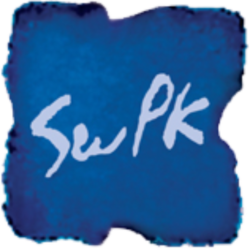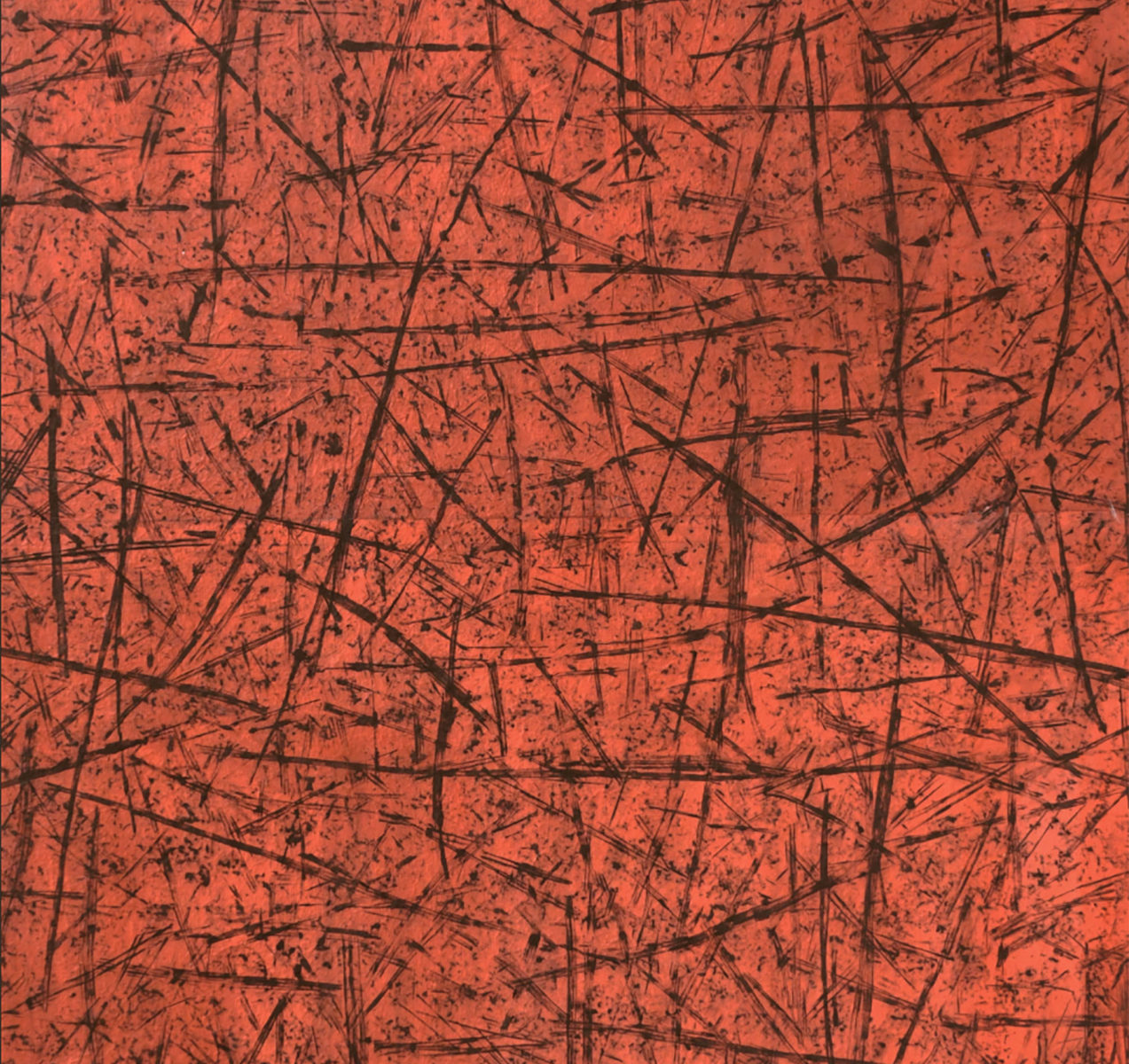NOVEMBER 16, 2023 – FEBRUARY 10, 2024
Young Sup Han (b. 1941) uses two and three dimensional works to explore the relation between form and phenomena. Forms, or the objects we see in front of us, are immediate and static, whereas phenomena are fluid and immaterial, such as the way the sunlight falls across the object. Han incorporates “indefinite natural phenomena” in his works, using materials such as boiled acorns, collected dirt, and dyed paper to capture the evocative expressions of nature.
Han’s use of Korean mulberry paper, hanji, and takbon is another manifestation of this meditation between the expression of form and the phenomena of nature through his art, while also expanding the boundaries of hanji techniques in contemporary art. Han employs the “Takbon” rubbing process, a form of Korean print making, over materials such as stones, twigs, perilla leaves and corn stems to create abstract patterns of bold, linear strokes that fill the entire surface with dynamic movement. The use of unconventional media, as well as the pressure and speed of his technique, create diverse textures that capture the beauty of the small, almost imperceptible changes found in nature.
Han’s practice focuses on the spirituality of nature and its correlation to the artist. The Korean philosophy of nature posits a complementary relationship between humans and nature – the self is inseparable from the surrounding environment. Rough, unpolished, and jagged lines imbue nature with sentiment. With hanji’s permeability for light and air, Han creates raw contours that portray the eternal and infinite cycles of nature. By manipulating the force and speed of his brush, Han seeks the undifferentiated state of the subject within a single movement. The abstract elements display the simplicity and poignancy inherent to the organic properties of hanji itself. Han’s forms capture the grandeur of nature that in- spires him, and the Infinite Relation between nature and self.
ABOUT YOUNG SUP HAN
Born in Gaecheon, Pyeongannam-do, Korea, Young Sup Han recently relocated to the U.S. He currently resides in New Jersey. He received an advanced degree at Dongguk University and is a Professor Emeritus of Sangmyung University in South Korea. His work has been exhibited in solo and group exhibitions globally such as the National Museum of Contemporary Art (Korea), Osaka Foundation of Culture (Japan), Hyogo Prefectural Museum of Art (Japan), Rade Museum (Germany), and Mt. San Antonio College Art Museum (US). His artwork is currently on view at the Guggenheim Museum, as part of the exhibition Only the Young: Experimental Art in Korea, 1960s-1970s.
The following is a review of Infinite Relation by Lilly Wei
Young Sup Han (b. 1941, Gaecheon, Pyeongannam-do, Korea)) is an artist of renown in South Korea but like many artists from non-European countries and cultures, he is not well-known in the United States. So, a few years ago, at around (a vigorous) 80 years of age, Han transplanted himself to America to establish a presence here and was seen in, among other ventures, “Only the Young: Experimental Art in Korea, 1960s-1970s” at the Guggenheim Museum as well as a solo show of recent and early work, “Infinite Relation,” at the Sylvia Wald Po Kim Foundation. That he came was not surprising since, as a pioneer, provocateur, and advocate for the experimental, he has always been open to new possibilities, propelled by a sense of adventure that is undiminished, qualities that are essential to those in search of new perspectives and new revelations. The art world, too, has once again revolved, perhaps even evolved, so that non-Western modernist paintings are being allotted many more chapters in an aesthetic narrative in need of reassessment and far greater expansion.
Han is primarily a painter who also makes three-dimensional works and while he is considered an abstractionist, the inspiration for his arresting, often ambitiously scaled works comes from nature; perhaps he might even be considered a proto-environmentalist of sorts, with his reverence for it. Like many Korean modernists, he has long explored innovative strategies to reconcile contemporary practices and traditional art, transforming the old into the new. Hanji (Korean mulberry paper), for instance, is retained as his preferred support as well as ink, a medium he uses frequently, but not exclusively. Oil paint, acrylic, dye, as well as boiled acorns and even dirt are also included in his non-canonical assortment of materials. Collage, which is both venerable and contemporary, and takbon, an ancient Korean rubbing technique that resembles printmaking or frottage, are two other signature Han techniques. In works such as Forest (2022) and Earth (2021), he rubs inkstick and acrylic energetically, forcefully against paper placed over stones, twigs, stalks, leaves, seeds, and other natural materials to capture their impressions, creating a thicket of quick, slashing lines and subtle textures. The grounds are monochromatic, the former a yellow green that suggests sunlight tinged by foliage, and red in the latter, evoking the color of fertile soil. This group of works is both a conceptual and abstract depiction of landscape, as well as something in-between, its imprint of actual objects from nature a more unmediated invocation of the real. What the artist is seeking is the essence of nature, not an illustration of it.
Han makes a distinction between that which is fixed and that which is fluid. He often refers to an epiphany, a vision of the sublime that he experienced in Norway while looking at the Baltic Sea one night, mesmerized by the constant movement and the infinitely changing patterns of light dappling the sea’s dark waters. From that came a powerful series of works, including one of his masterpieces, The Evening Baltic Ocean No. 7001 (2007). It is an immersive 17.5-foot-long horizontal ink painting, the countless black strokes that comprise it alternating with the hanji’s lighter tones, the staccato cadence of the markings summoning the rhythm of the sea’s ebb and flow, of its breathing. The beauty of its surface is rough but buoyant, a correlative to the immensity of nature and its restless ephemerality. These pragmatic and poetic musings (with a spiritual inflection) on nature and being, the material and immaterial, are poignant reminders that although everything is fleeting and will change, nature itself will endure—even if we do not.
ABOUT LILLY WEI
Lilly Wei is a New York-based independent curator, writer, journalist and critic focused on global contemporary art and emerging art and artists, reporting frequently on international exhibitions and biennials. She has written for dozens of publications here and abroad and is a longtime contributor to Art in America and a contributing editor at ARTnews. She is the author of numerous artists’ catalogues and monographs and has curated exhibitions in the United States, Europe and Asia. Wei lectures frequently on critical and curatorial practices and sits on the board of several non-profit art institutions and organizations including AICA/USA (the International Association of Art Critics), Bowery Arts & Sciences, and Art Omi International. She was a former board member of Art in General, and is a fellow of the CUE Foundation. Wei was born in Chengdu, China and has an MA in art history from Columbia University, New York.
Infinite Relation is produced in collaboration with the Donghwa Cultural Foundation.







